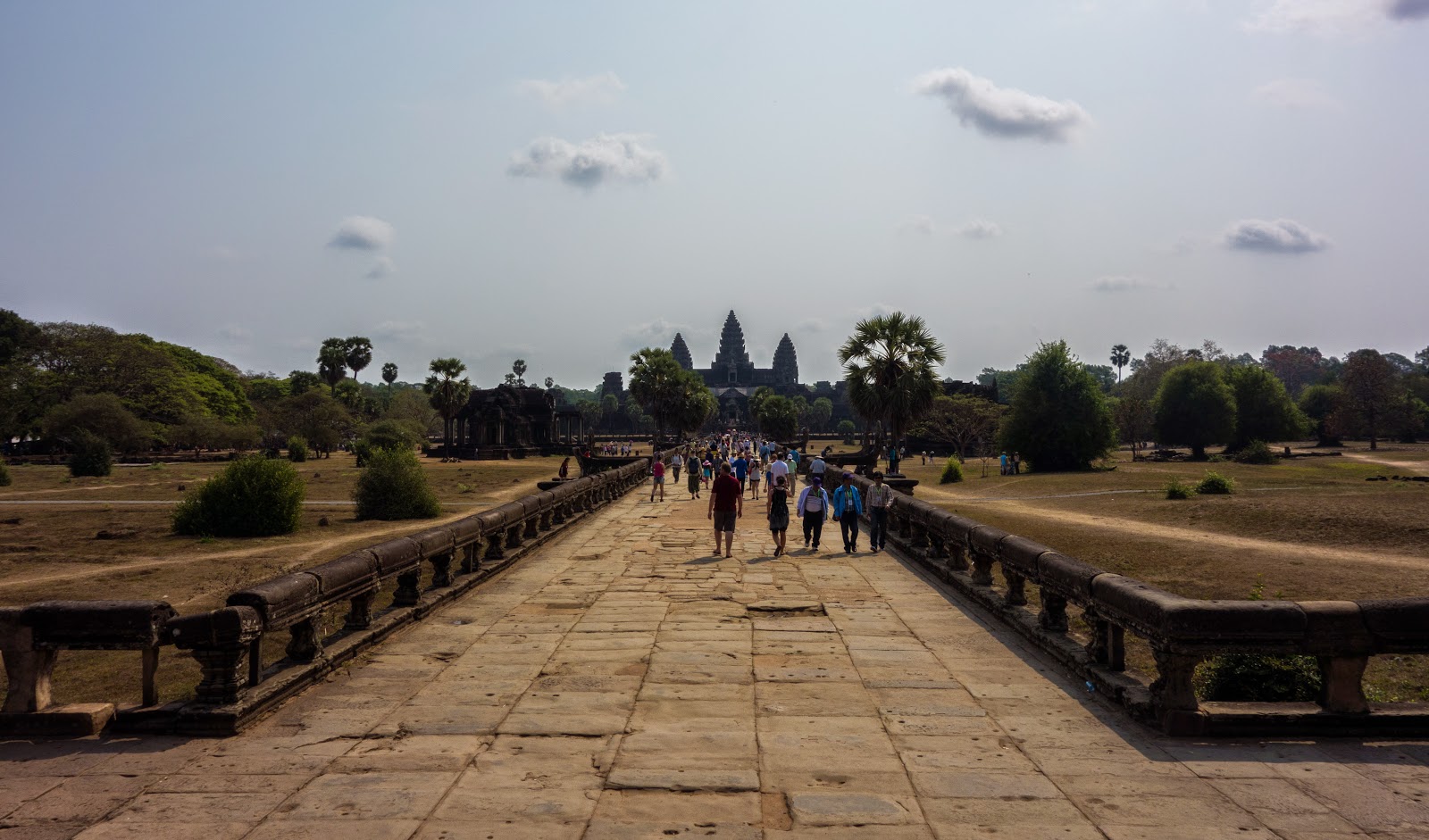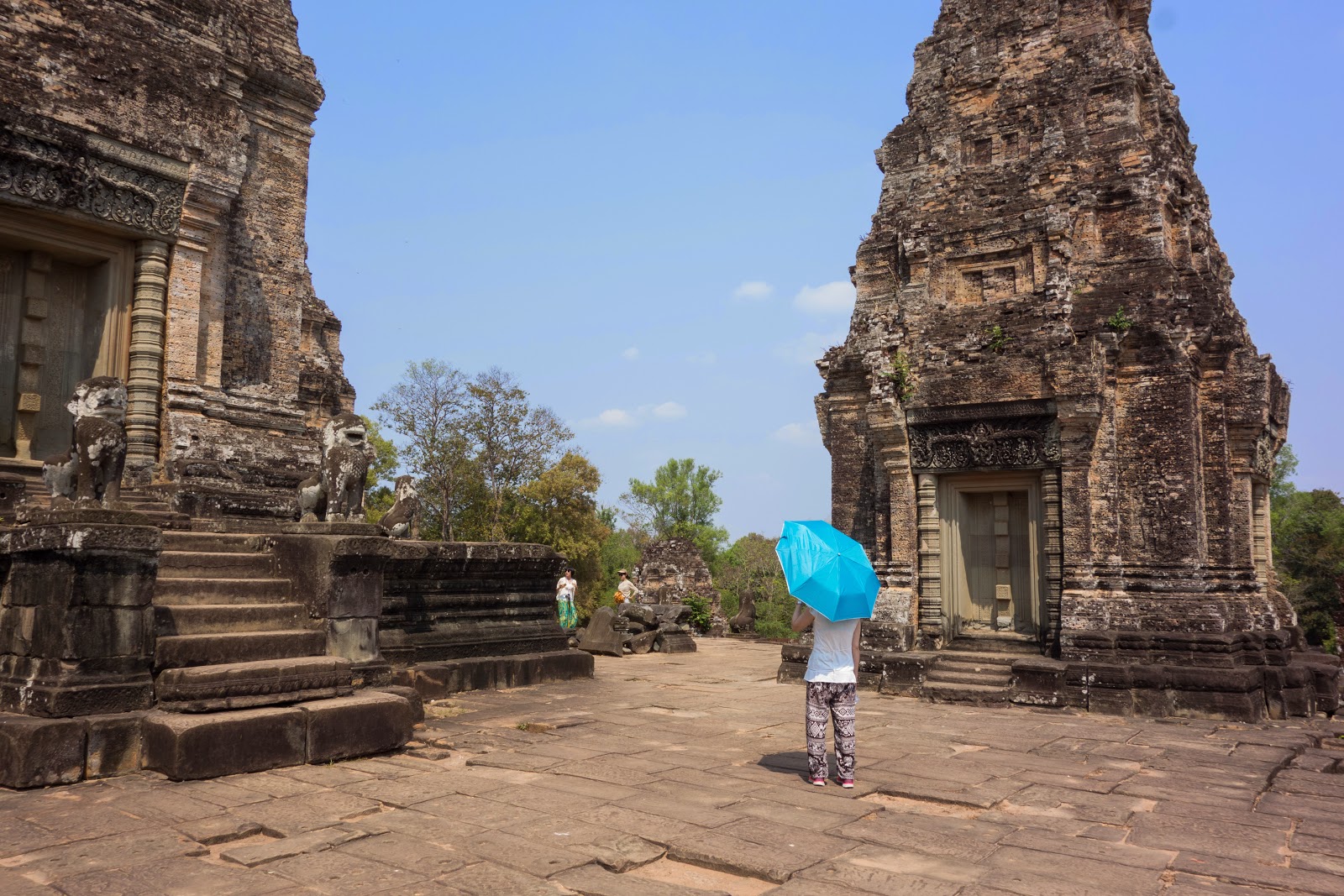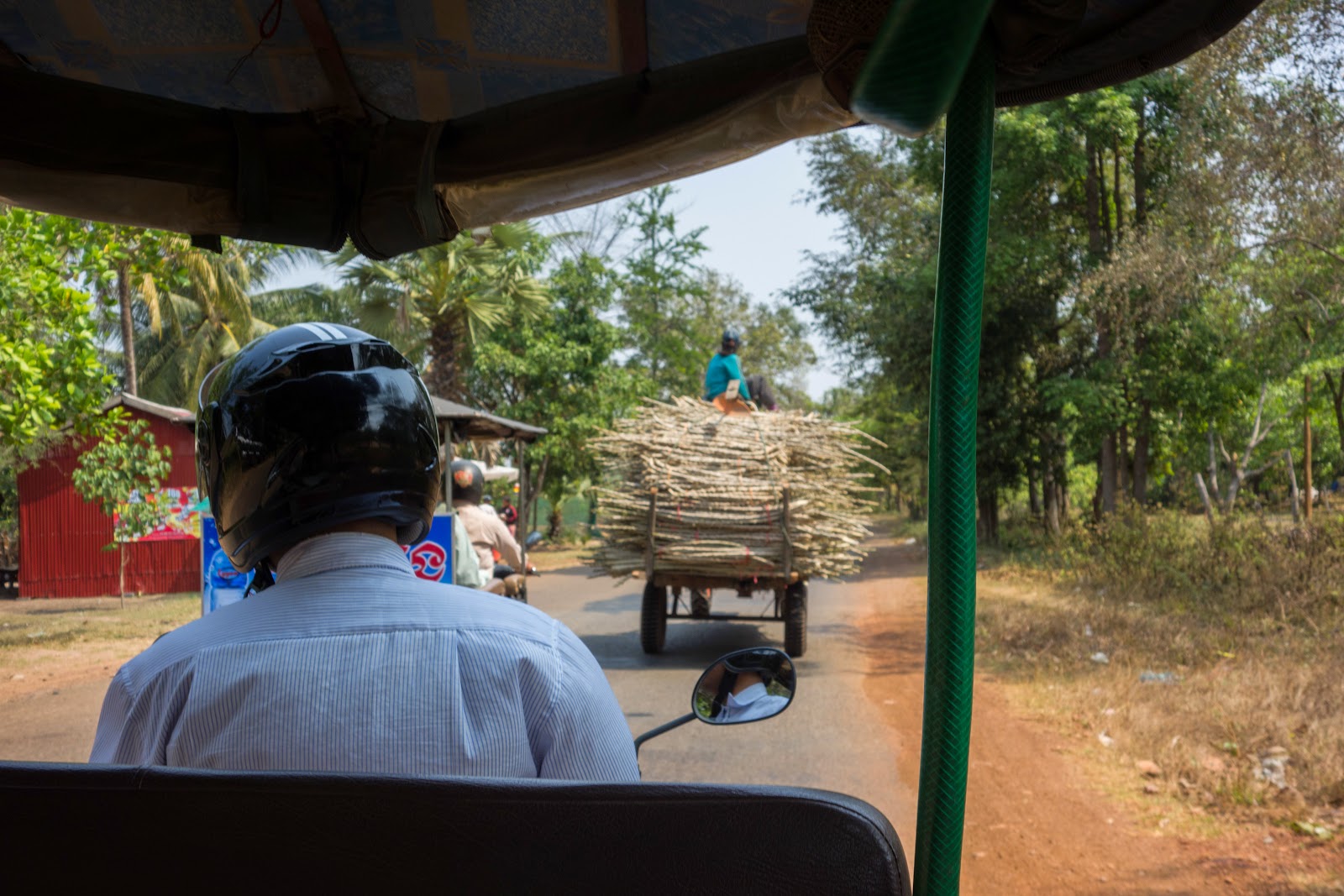It was long a dream of Jihyeon's to explore the temple ruins in Cambodia, so back in March this year we spent the best part of a week travelling around Angkor with a tuk tuk driver (review of our driver here) exploring the temple ruins and enjoying the delicious (but cheap) foods.
We flew into Siem Reap late Sunday evening with Korean air and made our way through customs. I got threw customs without any dramas, but Jihyeon was held up by a customer officer trying to scam money out of her. It was only $1 or $2, but it reaked of bullshit. In a country where the average yearly income is only $750 each, collecting $1 from each Korean that passes through the airport would pocket them a nice little bonus on top of what would already be generous salaries as government workers. It really soured the start of our holiday and put Jihyeon on guard for the rest of our trip.

The next morning we got up, had breakfast at our hotel and met our tuk tuk driver. We hired a Tuk Tuk for 4 days and it was absolutely the best decision. I was originally thinking about riding push bikes as I love cycling, but I'm happy we didn't. The weather was very very hot and humid and the temple complexes are massive. We wouldn't have been able to see half as much as we did if we rode push bikes, not to mention we wouldn't have known were to find air conditioned restaurants for lunch. I read a glowing review about Mr Sarorn and his Happiness Tuk Tuk on a expat forum, so decided to book him for the week to drive us around Siem Reap.
My Angkor travel tips:
- Hire a Tuk Tuk driver for the day. It's not that expensive and they will know where to go and the best times to go there. I recommend the Happiness Tuk Tuk.
- Take an umbrella with you even if it isn't raining. It will come in handy to take shelter from the sun.
- Be prepared to say no to a lot of people trying to sell you things. At every temple you go to there will be people trying to sell you clothes, souvenirs, water, fruit, or tours of the temple.
- Take USD in small bills.
- Don't give money or buy things from kids, because it really doesn't help them. If you want, you are best off to donate to a charity instead.
- Double check the bottled water you buy is sealed.
- Allow more time than you think you will need. Accommodation, food and transport is cheap so don't rush. Take things slow and enjoy your trip.
The first stop was the ticket office to buy a multi-day pass for exploring the ruins. Prices are US$20 for a 1 day pass, US$40 for a 3 day pass (1 week validity), and $60 for a 7 day pass (1 month validity). Each day as you pass through the check point an officer will punch a hole in your ticket. Occasionally as you enter temples, an officer will also ask to see your pass but they won't punch any new holes in it.
They take your photo with a webcam and print your picture out on the ticket.
Welcome to Angkor!
The temple complexes are huge. As we headed to our destination for today, Angkor Thom, we passed by the more well known Angkor Wat which we would visit another day.
About 10 minutes later we arrived at the gateway to Angkor Thom, which translated literally means "Great City". It was the last and most enduring capital city of the Khmer empire, covers 9 square kilometers, is home of several monuments and temples and is believed to have sustained a population of 80,000 to 150,000 people.
We stopped to climb the gateway.
And then continued through the gate towards Prasat Bayon.
The Bayon is a well known and richly decorated Khmer temple built in the late 12th century and stands in the center of what was the capital at the time, Angkor Thom.
This particular temple is a Mahayana Buddhist temple and consists of multiple galleries filled with intricate stone carvings depicting different battle scenes, victory feasts, war machines, and melee between warriors from opposing sides. There are also carvings of women tending to children, open-air cooking and market places, but mostly the carvings glorify different battles that the Khmer army fought. I guess if you want people to fight and die for you, you need to immortalise them in some way.
An elephan carving.
The galleries are housed in these arched sections, but in this temple and many of the other temples we visited the arched sections have collapsed, which is understandable considering they are hundreds of years old.
While tourists wander around the temples, the tuk tuk drivers chill out and relax in the shade.
Next to Prasat Bayon was Wat Preah Ngok, a Buddhist chapel.
Prasat Bayon though the trees and the stones from the collapsed archways littering the ground around the temple (I assume they were removed to make it safer/easier for tourists to explore the ruins).
We continued walking towards where our tuk tuk driver said he would meet us and stopped at Baphuon, another temple in Angkor Thom. Baphuon is a 3 tiered temple mountain dedicated to the Hindu god Shiva.
Baphuon was built in the mid 11th century, but converted to a Buddhist temple in the 15th century.
Restoration attempts of Baphuon proved problematic as it was built on sand.
But 51 years later in 2011 restoration was completed....
allowing sweaty tourists to find shelter from the scorching sun and take photos.
The entry to Baphuon.
Down the steep stairs and onto the next temple.
The rear of Baphuon temple.
And the entry to Phimeanakas.
Another gateway.
We then met up with our tuk tuk driver and stopped at a roadside stall selling fresh mango and pineapple.
Jihyeon, hot and tired after walking for the last 2 hours, reluctantly agreed to have her photo taken with the delicious mango and pineapple.
After the snack, we continued to the next temple.
We then left Angkor Thom and headed 1km east to Ta Prohm which was built in the last 12th century.
Ta Prohm was founded as a Buddhist monastery and university. Unlike most Angkorian temples, this one has been left in much the same condition in which it was found.
The temple is very photogenic which helped make it one of the most popular temples to visit.
After the fall of the Khmer Empire in the 17th century, the temple was abandoned and neglected until recently when restoration was begun.
but care is being taken not to ruin the picturesque ruins.
Here is before and after picture of a gallery that was restored.
And this is inside the gallery pictured above.
Ta Prohm is a "flat" Khmer temple, as opposed to a temple-pyramid or temple-mountain, with five rectangular walls surrounding a central sanctuary.
It is a really nice temple and I can definitely see why it is so popular. Jihyeon wasn't feeling well so we headed back to the hotel for a rest with the plan to return to the temple and finish exploring it tomorrow.
After a shower, a nap and some water we headed into Siem Reap to find "Pub Street", a street filled with restaurants and bars which are popular with foreign visitors.
The food was very cheap and tasty.
No complaints from me..
or Jihyeon.
The next day we visited Angkor Wat and took Gundi (my teddy bear) along for the ride.
Jihyeon was feeling much better and very excited to be visiting Angkor Wat.
The main entrance to Angkor Wat.
Like the temples we visited yesterday, there are large carving galleries built into the walls which depict battle scenes.
Gundi was too excited to stay in the backpack.
Once through the outer wall of Angkor Wat, we walked towards the central temple.
It was bloody hot so we took shelter and cooled off in a small stone building by the side of the path to the central Angkor Wat temple.
I can't imagine what it must have been like for the people that built these temples hundreds of years ago without any modern technology or tools in this heat.
You can see the central temple in the distance.
Gundi was hot in the back pack and wanted to cool down too.
We finally arrived at the central temple, looking back you can see the main gateway in the distance.
More carvings in a gallery.
More rock carvings, this time of a melee.
More carvings of warriors, this time they are going off to war.
And some more carvings. This one was of "hell".
We climbed up the central temple and got a good view of the surrounding forrest..
and the entry to Angkor Wat in the distance.
This is the very top of the Angkor Wat temple. Again, terribly hot.
Gundi ventured out briefly before returning to my cool bag packed with cold water.
One of the many shrines in the temple.
As I have said repeatedly, it was a bloody hot day and people were taking shelter from the sun wherever they could.
Another Angkor Wat shrine.
Our Tuk Tuk driver then took us to a air-conditioned restaurant for lunch. I can't remember the exact price, but it all came to under US$20 (3 dishes, soft drink and fresh hand made mango juice in an air-conditioned restaurant).
After stuffing our faces and cooling down, we then headed to Banteay Kdei.
This temple was also built in the 13th century.
Banteay Kdei is currently dilapidated due to fault construction and the poor quality sandstone originally used.
Despite it's dilapidated state, apparently it had been occupied by monks on and off again right up until the 1960's.
Jihyeon taking a break in the shade.
We then headed back to Ta Prohm (our visit here was cut short yesterday due to Jihyeon feeling unwell) to finish exploring the ruins. Just to recap, it is one of the most popular temples for tourists to visit because of its photogenic nature and atmosphere.
This time we entered from the opposite end of the temple so we didn't have to walk so far. I think this entry is actually nicer than the main entrance.
Ta Prohm was home to more than 12,500 people, including 18 high priests and 615 dancers. Additionally, 800,000 people lived in the surrounding villages providing services and supplies to the temple.
The records also indicate that the temple amassed considerable riches, including gold, pearls and silks.
Look at me, I can be a tree too!
I can see why this temple is so popular. I think it was my favourite. I would have liked it even more if there weren't so many tour groups (mostly Koreans) being shown around.
Jihyeon admiring the ruins.
We the jumped back in the tuk tuk and headed back to our hotel for the evening.
The next day we were up bright and early and headed to yet another temple. Morning traffic sucks.
A gateway on the Kings road.
Today we visited Preah Khan, which translated means "Royal Sword". Located northeast of Angkor Thom, it was the center of a substancial organisation, with almost 100,000 officials and servants.
Like nearby Ta Prohm, this temple has also been largely left unrestored and has a number of trees and other vegetation growing among the ruins.
A quick snap shot in front of the gate while wearing the ugly pants I finally broke down and bought after days of locals pestering me to buy pants. They broke a few hours later when I climbed into the tuk tuk.
The construction of this temple wasn't as planned as the others. From what I understand, it organically grew over time as more space was needed and this resulted in some buildings being packed together very closely.
Inside.....
and then outside (same tree as above).
The trees are slowly destroying the temple, but at the same time holding it up.
Yet another temple.... They were all starting to look the same to me.
Another awesome tree growing over a doorway holding it up.
Lunch time! Our tuk tuke driver took us to another Air-conditioned restaurant. I don't remember how much it cost, but it was quite cheap and definitely under $20 again.
Loving the fresh hand made mango juice made from real mango's.
After lunch we stopped at Pre Rup, a temple built in the 10th century mostly from bricks rather than stone. I think it was the hottest temple we had visited yet.
Pre Rup was dedicated tot he Hindu god Shiva.
I don't know how these flowers survive in the heat.
All the temples have very steep stairs. The picture doesn't do the steepness justice. It reminded me a little of scrambling up Mt Tibrogargan.
All the towers are hollow and have alters for people to make offerings and worship at.
We headed down and back to our tuk tuk driver who, as usual, greeted us with cold bottles of water.
Stopped by the next temple. I don't remember the name of this one. They were all starting to look the same to me.
Climbed all the way to the top.
I do remember at the top of this temple a tour guide started talking to us and told us how bored he was with his job (he had sat at the top of this temple for 10 years) and how badly paid he was. Sorry buddy, but all you did was make me feel uncomfortable.
Another temple just by the side of the road. I don't remember the name of this one either, but it was in very good condition.
On the way to our next stop, we climbed the wall and took a photo next to the giant heads carved into the King's gateway.
Back to the tuk tuk!
We then went to Phnom Bakheng, a temple perched on top of the only mountain around, to view the sunset. From the top, you could see Angkor Wat in the distance.
the sun took forever to go down.
Because the sky was so hazy, the sunset in my opinion wasn't that spectacular. I instead experimented with taking some high contrast photos.
The sun was taking forever to set, Jihyeon was tired, and I was hungry, so we gave up waiting for the sun to set and headed back down the mountain.
The next day was our last day of checking out ruins. We got up bright and early and started our long tuk tuk ride (about 1.5 hours from memory) out to some ruins further from the main Angkor complexes.
Fresh fruit and water for sale by the side of the road.
It took me a while to work out what this guy was selling, but then I realised! He is selling 2 litre coke bottles full of fuel.
One of the many monkeys we saw by the side of the road.
We didn't stop to ride the elephants, but we passed this guy at Prasat Bayon.
We stopped at Prasat Bayon to take a photo with our tuk tuk driver and his tuk tuk.
And then continued on our way. Since it was such a long journey, Gundi decided to join us in the tuk tuk.
It was interesting driving through the country side passing people's homes and farms.
No photo!
Some stalls by the side of the road. We were a pretty long way from the tourist hot spots, so I don't know how much business they would get here.
Safety first!
We then arrived at Banteay Srey, which loosely translates to "citadel of the women".
This temple displays some of the finest examples of classical Khmer art. The walls are densely covered with deep intricate carvings, deeper than any of the other temples we went to visit.
We then hit the road again and continued to Kbal Spean. The site consists of a series of stone carvings in the river bed and banks and is commonly known as the "Valley of 1000 Lingas".
It is a bit of a walk (about 1km from memory), but the path is well marked and not too steep.
Finally, we arrived. This is the start of the carvings in the river bed. The idea was that the water (the life blood of their society) would be blessed by passing over the carvings.
For about 150 meters down the river's headwaters, there are carvings in the riverbed.
At the end is a waterfall where we took our shoes off and rested in the cool refreshing water.
Nearby, a group of butterflies were drinking/resting in the sun.
Even Gundi cooled off in the water.
We then headed back to our tuk tuk driver who took us to a restaurant almost straight across the road from Kbal Spean.
On the railing there were some enormous ants.
It was then back to Siem Reap for dinner. Lasagne and Pizza.
The next day we just chilled out in Siem Reap and waited for our flight. In the morning we got foot massages (really cheap) and then grabbed some lunch at a restaurant I don't remember the name of. It was good food, but damn it annoys me how people think it is trendy to serve food on things that are not plates.
The customs officials tried to scam Jihyeon out of US$1 on the way out again, but apart from that all up it was a good trip. We might go back in 10 or 20 years once they have completed some more restoration work.












































































































































































































